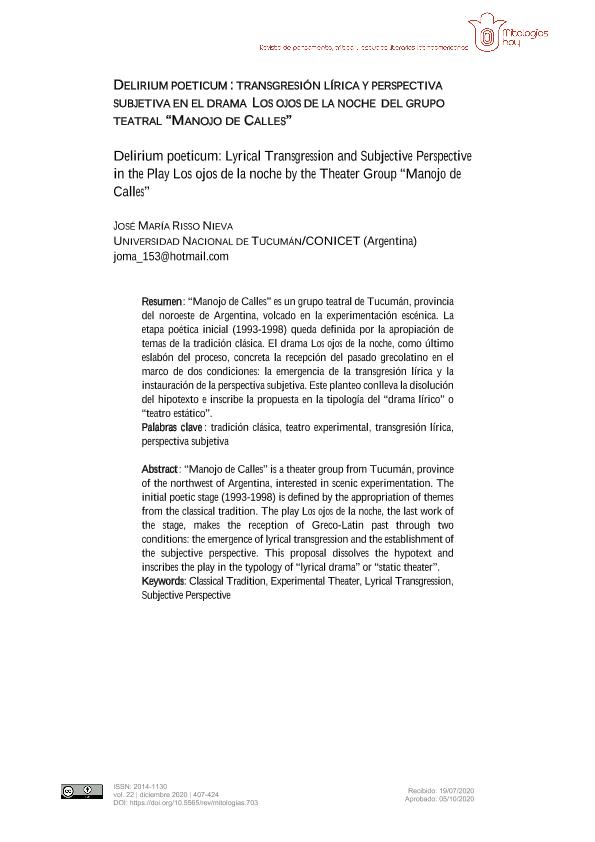Artículo
“Manojo de Calles” es un grupo teatral de Tucumán, provincia del noroeste de Argentina, volcado en la experimentación escénica. La etapa poética inicial (1993-1998) queda definida por la apropiación de temas de la tradición clásica. El drama Los ojos de la noche, como último eslabón del proceso, concreta la recepción del pasado grecolatino en el marco de dos condiciones: la emergencia de la transgresión lírica y la instauración de la perspectiva subjetiva. Este planteo conlleva la disolución del hipotexto e inscribe la propuesta en la tipología del “drama lírico” o “teatro estático”. “Manojo de Calles” is a theater group from Tucumán, province of the northwest of Argentina, interested in scenic experimentation. The initial poetic stage (1993-1998) is defined by the appropriation of themes from the classical tradition. The play Los ojos de la noche, the last work of the stage, makes the reception of Greco-Latin past through two conditions: the emergence of lyrical transgression and the establishment of the subjective perspective. This proposal dissolves the hypotext and inscribes the play in the typology of “lyrical drama” or “static theater”.
Delirium poeticum: transgresión lírica y perspectiva subjetiva en el drama Los ojos de la noche del grupo teatral Manojo de Calles
Título:
Delirium poeticum: Lyrical Transgression and Subjective Perspective in the Play Los ojos de la noche by the Theater Group “Manojo de Calles”
Fecha de publicación:
12/2020
Editorial:
Universitat Autónoma de Barcelona
Revista:
Mitologías hoy
ISSN:
2014-1130
e-ISSN:
2014-1130
Idioma:
Español
Tipo de recurso:
Artículo publicado
Clasificación temática:
Resumen
Archivos asociados
Licencia
Identificadores
Colecciones
Articulos(INVELEC)
Articulos de INSTITUTO DE INVESTIGACIONES SOBRE EL LENGUAJE Y LA CULTURA
Articulos de INSTITUTO DE INVESTIGACIONES SOBRE EL LENGUAJE Y LA CULTURA
Citación
Risso Nieva, José María; Delirium poeticum: transgresión lírica y perspectiva subjetiva en el drama Los ojos de la noche del grupo teatral Manojo de Calles; Universitat Autónoma de Barcelona; Mitologías hoy; 22; 12-2020; 407-424
Compartir
Altmétricas




